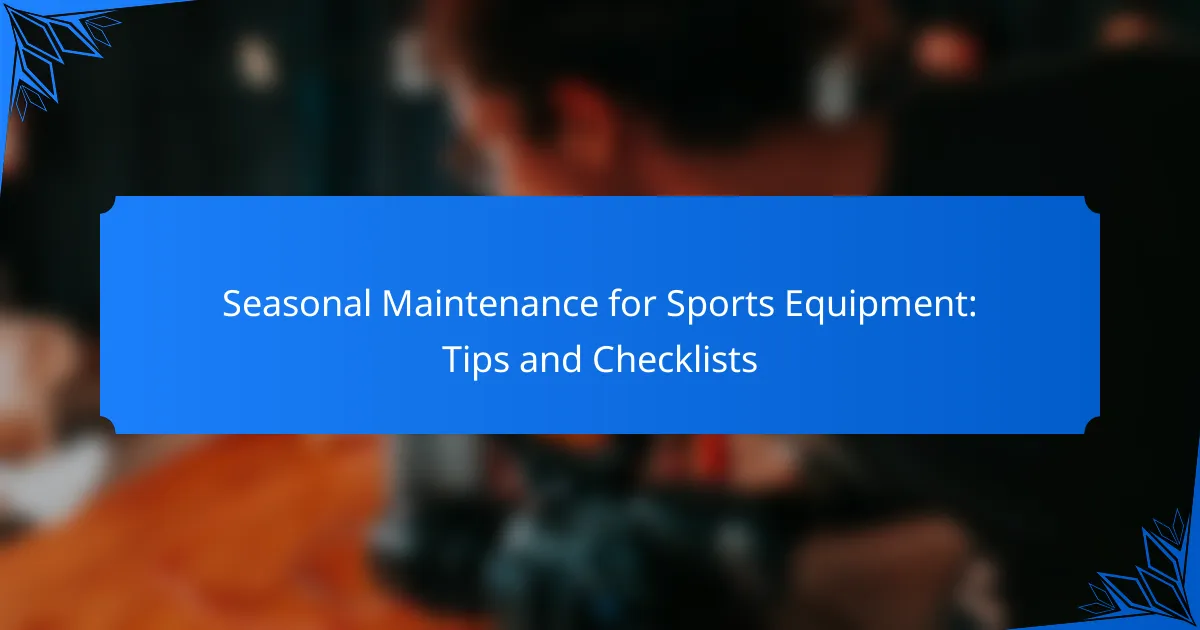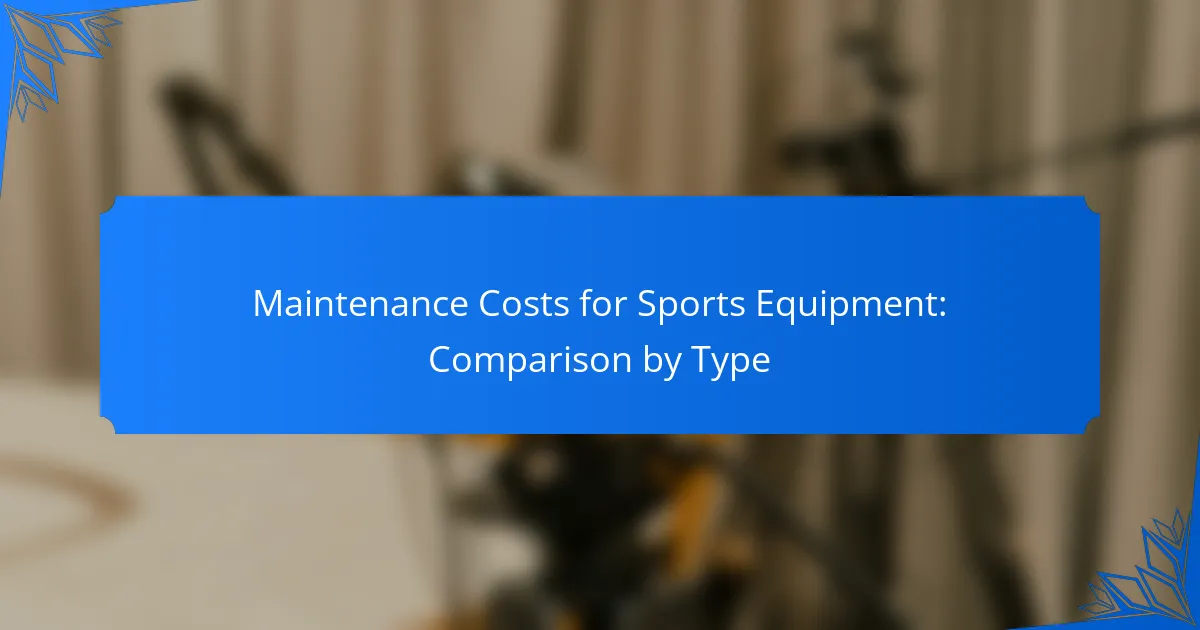Seasonal maintenance for sports equipment is essential for ensuring safety, performance, and longevity. By following specific tips and checklists, you can effectively clean, inspect, and store your gear, preventing costly repairs and enhancing your overall experience. Whether it’s preparing your bicycle for winter or maintaining other sports equipment, regular upkeep is key to enjoying your activities to the fullest.
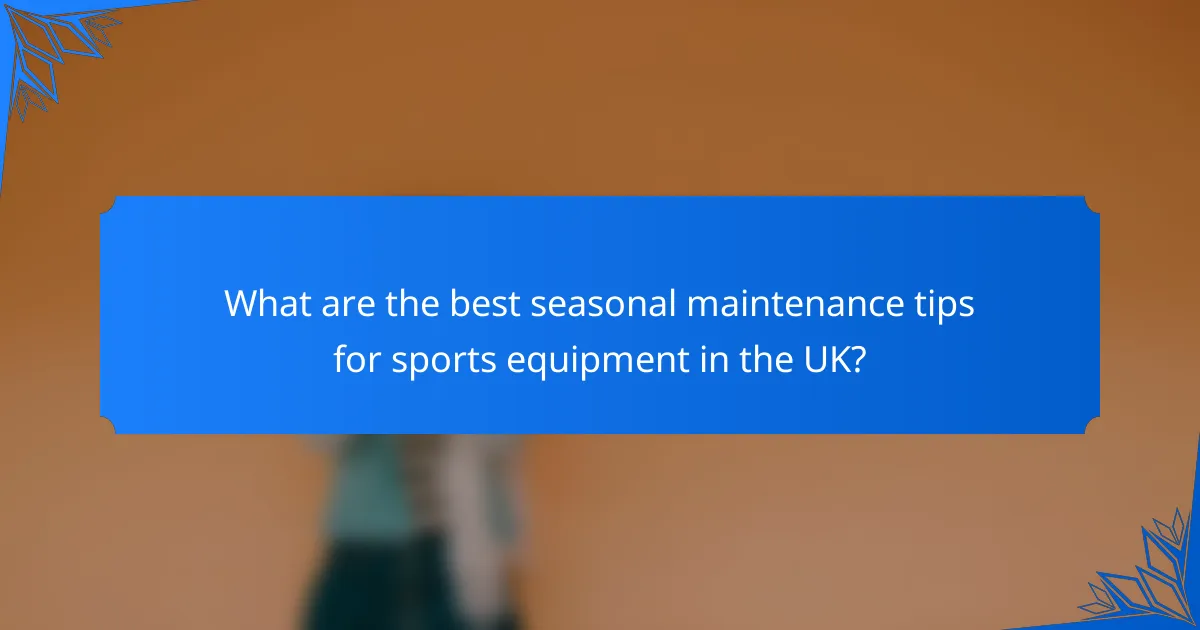
What are the best seasonal maintenance tips for sports equipment in the UK?
Seasonal maintenance for sports equipment in the UK involves regular cleaning, proper storage, and thorough inspections to ensure longevity and performance. Following these tips can help prevent costly repairs and enhance safety during use.
Regular cleaning and inspection
Regular cleaning is essential to maintain the performance and appearance of sports equipment. Use appropriate cleaning agents for each type of gear, such as mild soap for synthetic materials and specialized cleaners for specific surfaces.
During inspections, check for any visible signs of damage or dirt accumulation. Make it a habit to inspect your equipment after each use, especially if it has been exposed to harsh weather conditions.
Proper storage techniques
Proper storage is crucial for preserving the condition of sports equipment. Store items in a cool, dry place, away from direct sunlight and moisture, which can cause deterioration.
Utilize storage solutions like racks, hooks, or bags designed for specific sports equipment. For example, hang bikes vertically to save space and prevent tire deformation.
Lubrication of moving parts
Lubricating moving parts is vital for ensuring smooth operation and preventing wear. Use the recommended lubricants for each type of equipment, such as silicone spray for bike chains or oil for hinges on gym equipment.
Apply lubricant sparingly and wipe off any excess to avoid attracting dirt. Regular lubrication should be part of your maintenance routine, ideally every few weeks or after heavy use.
Checking for wear and tear
Regularly checking for wear and tear helps identify potential issues before they become serious problems. Look for frayed straps, cracked frames, or worn-out soles on footwear.
Establish a routine inspection schedule, ideally at the start and end of each season. This proactive approach can save you from unexpected failures during critical moments.
Replacing damaged components
Replacing damaged components promptly is essential for safety and performance. If you notice any part of your equipment is compromised, such as a broken strap or a worn-out tire, replace it immediately to avoid accidents.
Keep a list of replacement parts specific to your equipment and their expected lifespan. This will help you stay organized and ensure you have the necessary components on hand when needed.

How can I maintain my bicycle for winter conditions?
To maintain your bicycle for winter conditions, focus on cleaning, inspecting, and protecting key components to ensure optimal performance and longevity. Proper winter maintenance helps prevent rust, ensures safety, and enhances your riding experience in cold weather.
Cleaning the drivetrain
Cleaning the drivetrain is essential for smooth operation during winter. Start by removing any dirt, grime, and salt buildup from the chain, cassette, and derailleur using a degreaser and a brush. Rinse with water and dry thoroughly to prevent corrosion.
After cleaning, apply a suitable lubricant designed for cold weather to the chain. This helps repel moisture and reduces wear. Aim to clean your drivetrain every few weeks during winter, or more frequently if you ride in harsh conditions.
Inspecting brakes and tires
Inspecting brakes and tires is crucial for safety in winter riding. Check the brake pads for wear and ensure they make proper contact with the rim or rotor. Replace any worn pads to maintain effective stopping power.
For tires, look for adequate tread depth and check for any cracks or punctures. Consider switching to winter-specific tires with better grip if you frequently ride on icy or snowy surfaces. Keeping tire pressure at the recommended level is also important, as cold temperatures can reduce it significantly.
Applying protective coatings
Applying protective coatings can help shield your bicycle from the harsh elements of winter. Use a rust inhibitor on metal parts, especially the frame and components exposed to moisture. This creates a barrier against rust and corrosion.
Additionally, consider using a waterproof sealant on the frame and components to provide extra protection. Regularly reapply these coatings throughout the winter season, particularly after cleaning your bike, to maintain their effectiveness.
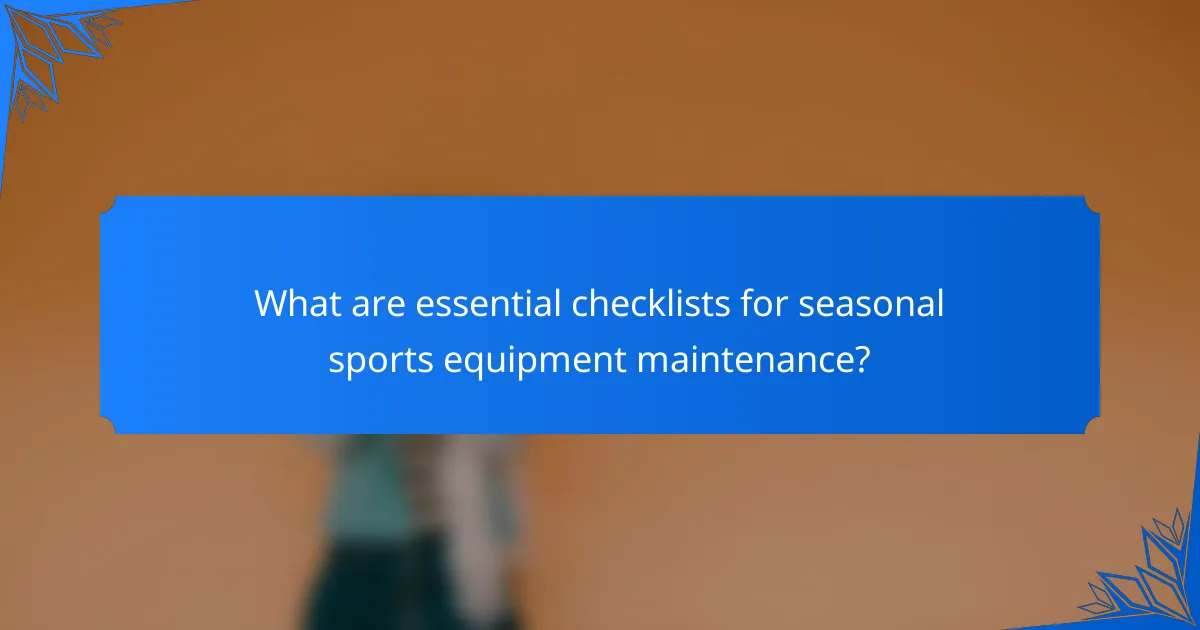
What are essential checklists for seasonal sports equipment maintenance?
Essential checklists for seasonal sports equipment maintenance help ensure that your gear is safe, functional, and ready for use. Regular maintenance can extend the lifespan of your equipment and enhance performance, making it crucial for athletes and outdoor enthusiasts alike.
Bicycle maintenance checklist
For bicycle maintenance, focus on key components such as brakes, tires, and gears. Check brake pads for wear, ensure tires are properly inflated, and inspect the chain for lubrication and rust.
- Inspect brake pads and cables.
- Check tire pressure and tread condition.
- Lubricate the chain and gears.
- Examine the frame for any damage or rust.
Performing these checks regularly, ideally before the cycling season, can prevent accidents and improve your riding experience.
Skis and snowboards maintenance checklist
Maintaining skis and snowboards involves checking the edges, bases, and bindings. Look for any nicks or scratches on the edges and ensure the bindings are functioning correctly.
- Inspect edges for damage and sharpen if necessary.
- Check the base for gouges and wax it for optimal performance.
- Test bindings to ensure they release properly.
These steps should be taken before the winter season to ensure safety and enhance performance on the slopes.
Football gear maintenance checklist
Football gear maintenance is essential for safety and performance. Regularly inspect helmets, pads, and cleats for any signs of wear or damage.
- Check helmets for cracks and ensure padding is intact.
- Inspect shoulder pads and other protective gear for tears.
- Examine cleats for proper traction and replace if worn.
Conduct these checks before the start of the season to avoid injuries and ensure that all equipment meets safety standards.
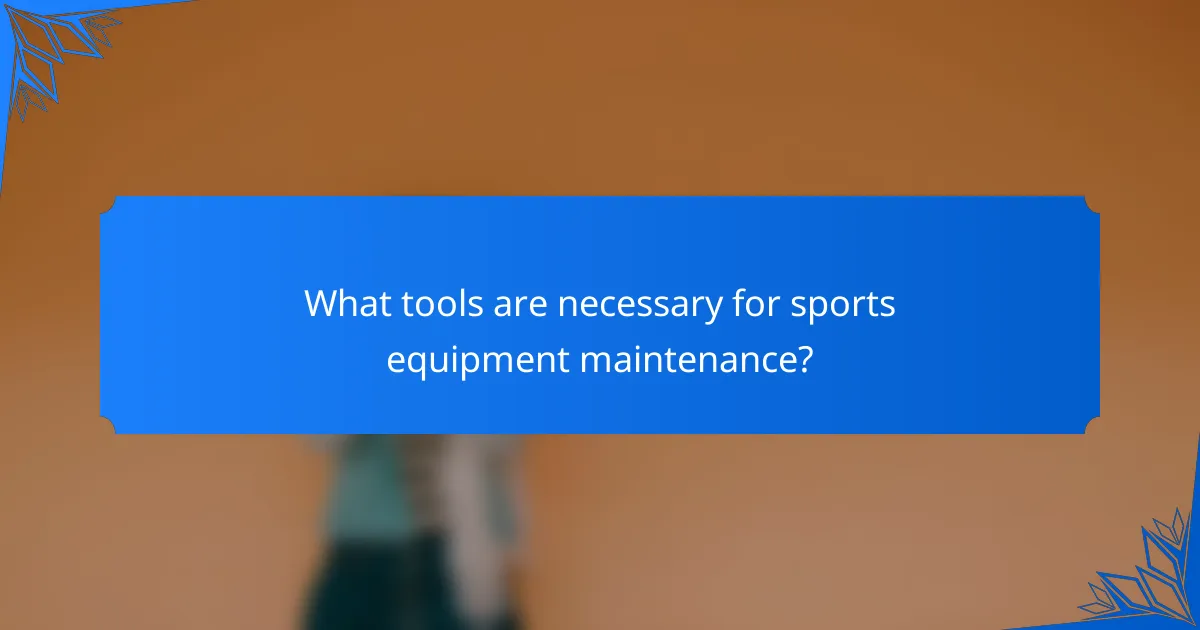
What tools are necessary for sports equipment maintenance?
Essential tools for sports equipment maintenance vary by sport but generally include basic hand tools, cleaning supplies, and specific equipment tailored to each type of gear. Having the right tools on hand ensures that your equipment remains in top condition and can extend its lifespan.
Basic tool kit for bicycles
A basic bicycle maintenance toolkit should include a tire lever, a multi-tool with various wrenches, a pump, and a patch kit. These tools allow you to handle common issues like flat tires, brake adjustments, and gear tuning.
Consider adding a chain cleaner and lubricant to your kit for regular upkeep. Keeping your chain clean and lubricated can significantly improve performance and prolong the life of your bike components.
Essential tools for ski maintenance
For ski maintenance, you will need a ski tuning kit that includes a file, a scraper, and a waxing iron. These tools help maintain the edges and bases of your skis, ensuring optimal performance on the slopes.
It’s also beneficial to have a brush for cleaning the bases and a vice to hold the skis steady while you work. Regular tuning can enhance your skiing experience and improve safety by ensuring better control.
Football gear cleaning supplies
Cleaning football gear requires specific supplies such as mild detergent, a soft brush, and a microfiber cloth. These items help remove dirt and sweat without damaging the materials.
For helmets and pads, consider using disinfectant wipes to eliminate bacteria and odors. Regular cleaning not only maintains hygiene but also extends the life of your equipment, keeping it safe for use during the season.

How does seasonal maintenance impact sports performance?
Seasonal maintenance is crucial for optimizing sports performance as it ensures that equipment functions correctly and safely. Regular upkeep can prevent injuries and enhance the overall experience for athletes by keeping gear in top condition.
Improved safety and reliability
Regular maintenance of sports equipment significantly enhances safety and reliability. For instance, checking for wear and tear on items like helmets, pads, and shoes can prevent accidents caused by equipment failure. Athletes should inspect their gear at the start of each season to ensure it meets safety standards.
Common maintenance tasks include tightening screws, replacing worn-out parts, and cleaning equipment to remove dirt and debris. Following manufacturer guidelines for care can further improve safety and reliability.
Enhanced equipment lifespan
Seasonal maintenance can greatly extend the lifespan of sports equipment. Simple actions such as cleaning, lubricating moving parts, and storing items properly can prevent deterioration. For example, storing bicycles indoors during winter can protect them from rust and damage.
Investing time in maintenance can save money in the long run by delaying the need for replacements. Athletes should create a maintenance schedule to keep track of necessary tasks throughout the year.
Better performance outcomes
Properly maintained sports equipment leads to better performance outcomes. For example, a well-tuned tennis racket can improve shot accuracy and power, while a properly inflated basketball ensures optimal bounce. Athletes should regularly check their equipment to ensure it is performing at its best.
Additionally, maintaining gear can enhance comfort and reduce fatigue during play. Athletes should prioritize adjustments and repairs before competitions to ensure peak performance when it matters most.
